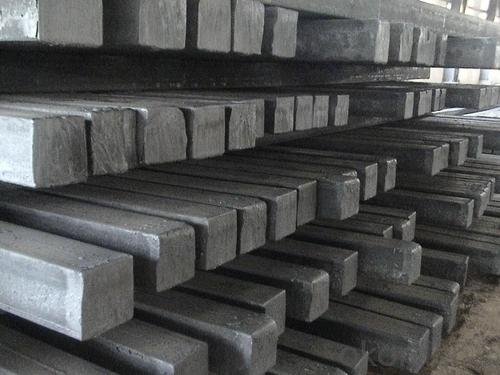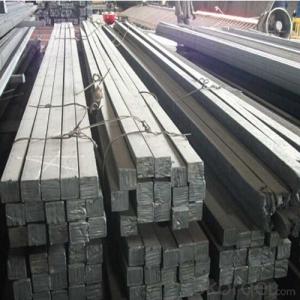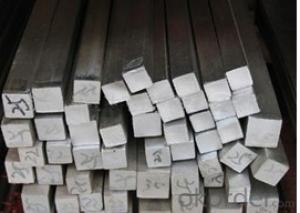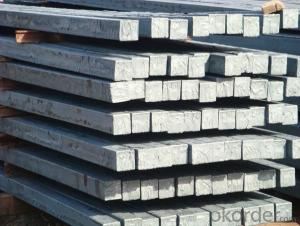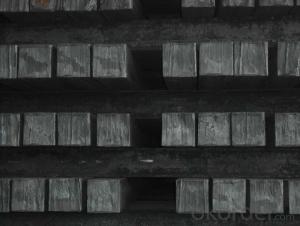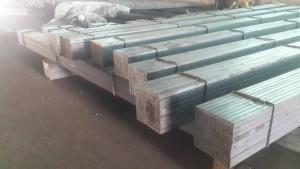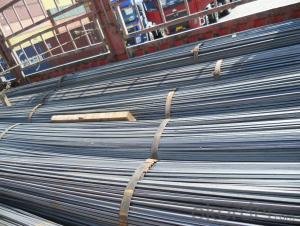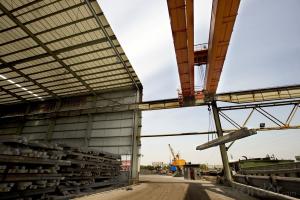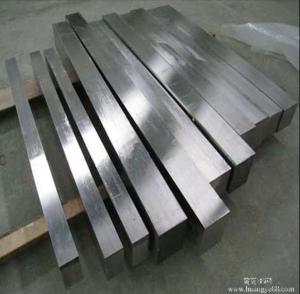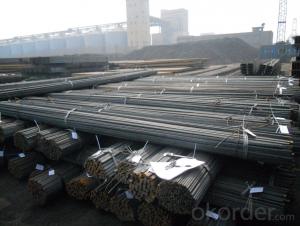hor rolled steel billet
- Loading Port:
- China Main Port
- Payment Terms:
- TT OR LC
- Min Order Qty:
- -
- Supply Capability:
- -
OKorder Service Pledge
OKorder Financial Service
You Might Also Like
Product Description:
We offer Square Steel Bar with grade Q195 / Q235
Specifications of Square Steel Bar:
-Standard: GB,
-Grade: Q195/Q235 or equivalent.
Chemical Composition:
-Chemical Composition. Q195
Standard | Grade | Element (%) | ||||
GB | Q195 | C | Mn | S | P | Si |
0.06~0.12 | 0.25~0.50 | ≤0.050 | ≤0.045 | ≤0.30 | ||
-Chemical Composition. Q235
Standard | Grade | Element (%) | ||||
GB | Q235B | C | Mn | S | P | Si |
0.12~0.20 | 0.30~0.70 | ≤0.045 | ≤0.045 | ≤0.30 | ||
Measures and Tolerances of Square Steel Bar:
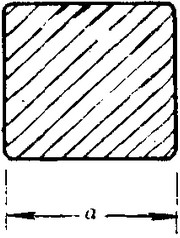
(The section of Square Steel Bar)
-The length of a side and the theoretical weight of Square Steel.
Length of a side(a, mm) | Theoretical weight(kg/m) | Length of a side(a, mm) | Theoretical weight(kg/m) |
6 | 0.283 | 32 | 8.04 |
7 | 0.385 | *33 | 8.55 |
8 | 0.502 | 34 | 9.07 |
9 | 0.636 | *35 | 9.62 |
10 | 0.785 | 36 | 10.17 |
11 | 0.950 | 38 | 11.24 |
12 | 1.13 | 40 | 12.56 |
13 | 1.33 | 42 | 13.85 |
14 | 1.54 | 45 | 15.90 |
15 | 1.77 | 48 | 18.09 |
16 | 2.01 | 50 | 19.63 |
17 | 2.27 | 53 | 22.05 |
18 | 2.54 | *55 | 23.6 |
19 | 2.82 | 56 | 24.61 |
20 | 3.14 | *58 | 26.4 |
21 | 3.46 | 60 | 28.26 |
22 | 3.80 | 63 | 31.16 |
*23 | 4.15 | *65 | 33.17 |
24 | 4.52 | *68 | 36.3 |
25 | 4.91 | 79 | 38.49 |
26 | 5.30 | 75 | 44.16 |
*27 | 5.72 | 80 | 50.24 |
28 | 6.15 | 85 | 56.72 |
*29 | 6.60 | 90 | 63.59 |
30 | 7.06 | 95 | 70.85 |
*31 | 7.54 | 100 | 78.50 |
Notes:
1, The theoretical weights in the list, base on the density of 7.85 g/cm3.
2, The numbers with *mean that they are not regulars or we don’t offer them.
-The allowed tolerance of Square Steel:
Length of a side(mm) | Allowed Tolerance | ||
Group1 | Group2 | Group3 | |
5.5~7 | ±0.20 | ±0.30 | ±0.40 |
7~20 | ±0.25 | ±0.35 | ±0.40 |
20~30 | ±0.30 | ±0.40 | ±0.50 |
30~50 | ±0.40 | ±0.50 | ±0.60 |
60~80 | ±0.60 | ±0.70 | ±0.80 |
80~110 | ±0.90 | ±1.0 | ±1.1 |
110~150 | ±1.2 | ±1.3 | ±1.1 |
150~190 | ―― | ―― | ±2.0 |
190~250 | ―― | ―― | ±2.5 |
Usage/Applications of Steel Square Bar:
-The Square Steel is normally used as structure steel.
-Row material for other structure steel like steel angles, channels, I-beams, H-beams, etc…
Packaging & Delivery of Steel Square Bar:
-Packing Detail: The products can be packed in bundles by steel wires.
-Marks:
1, Tag marks: the tag marks will be tied up to each bundle of the products. The information is usually including supplier’s logo and name, product name, made in China, products’ specifications, the painted color and other information requested by customers.
2, Color marks: we will paint both ends of the bundles of these products to make sure that they are more evident. It’s will be more convenient for the customers to distinguish them at the destination port.
-Delivery Detail: 30~45 working days after receive buyer’s T.T. or L/C.
Transportation:
-The products can be delivered by bulk vessel or by container. As for container, products with the length of 6m will be loaded in 20’ container, with 9m or 12m, in 40’ container.
-The maximum quantity of loading of container is 25 tons.
-The products usually are transported to the nearest port from the production place.
Payment:
-Invoicing on theoretical weight or actual weight a s customer’s request.
-FOB, CFR or CIF.
-Regular terms of payment:
1, 30% payment in advance, the remaining balance (70% payment) against the copy of B/L.
2, 30% payment in advance, the remaining balance (70% L/C) against the copy of B/L.
3, Negotiable.
Photos of Square Steel Bar:
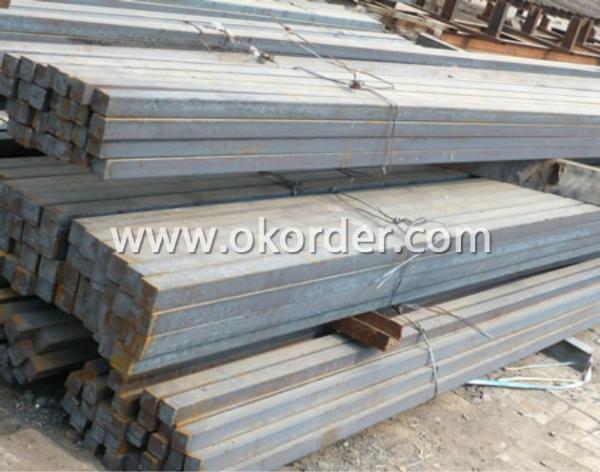
- Q: How accurate are steel squares?
- Steel squares are generally considered to be highly accurate measuring tools. Their accuracy depends on the quality of the manufacturing and the precision of the markings on the square itself. High-quality steel squares have precise angles and straight edges, allowing for accurate measurements and squareness checks. However, it is important to note that even the best steel squares may have slight variations due to manufacturing tolerances. To ensure the accuracy of a steel square, it is recommended to check it against a known reference or a precision measuring instrument. This can be done by placing the square against a flat surface and verifying that the edges are parallel and the angles are square. If any discrepancies are found, adjustments can be made or the square can be replaced if necessary. Overall, steel squares are generally reliable and accurate tools for measuring and checking squareness. However, it is always important to verify their accuracy and perform regular maintenance to ensure their continued precision.
- Q: Can a steel square be used for drawing straight lines?
- Yes, a steel square can be used for drawing straight lines. A steel square, also known as a framing square or a carpenter's square, is a versatile tool used in carpentry and other trades. It consists of two arms, one longer than the other, which meet at a right angle. The longer arm usually has measurements marked along its edge, allowing for accurate measurements and angles. To draw a straight line using a steel square, one can align the longer arm of the square with the desired line and hold it securely in place. By using a pencil or a marking tool against the edge of the longer arm, one can then easily draw a straight line. The steel construction of the square ensures its durability and stability, making it a reliable tool for drawing straight lines. However, it is important to note that the accuracy of any straight line drawn with a steel square depends on proper alignment and positioning of the tool. It is recommended to use a level or another straight edge to double-check the accuracy of the line. Additionally, when using the steel square, it is essential to hold it firmly and steady to prevent any unintentional movement that could affect the straightness of the line.
- Q: Can a steel square be used for deck railing layout and installation?
- Yes, a steel square can be used for deck railing layout and installation. A steel square is a versatile tool that provides accurate angles and measurements, making it suitable for ensuring precise and proper installation of deck railings.
- Q: Can a steel square be used for checking the squareness of a picture frame?
- Indeed, the squareness of a picture frame can be assessed by employing a steel square. Functioning as a measuring instrument, the steel square possesses a 90-degree angle, rendering it suitable for gauging right angles. Simply position the steel square against the picture frame's corners, and effortlessly ascertain whether the frame is flawlessly square or if any inconsistencies exist. In the event that the frame is not square, one can rectify the situation by making necessary adjustments to ensure proper alignment of the corners and straightness of the frame.
- Q: How do you use a steel square to lay out a mortise and tenon joint?
- To use a steel square to lay out a mortise and tenon joint, follow the steps below: 1. Start by marking the location of the tenon on the end of the workpiece. The tenon is the projecting part of the joint that will fit into the mortise. 2. Place the steel square against the end of the workpiece, aligning it with the edge. Ensure that the square is held firmly against the wood to get accurate measurements. 3. Use the square's blade to mark the width of the tenon on the face of the workpiece. Slide the square along the edge, keeping it square to the face, and draw a line across the width of the tenon. 4. Next, mark the length of the tenon by measuring from the end of the workpiece. Position the square's tongue against the edge, aligning it with the end of the wood. Slide the square along the edge, drawing a line across the width of the tenon to mark its length. 5. Now, it's time to mark the mortise on the corresponding piece of wood. Place the tenoned piece against the other workpiece, ensuring that their edges align properly. 6. Transfer the lines marked on the tenon to the face of the second workpiece by using the square. Position the square's blade against the face of the second piece and align it with the lines marking the width and length of the tenon. Draw lines across the width and length to outline the mortise. 7. Finally, use a chisel or a router to remove the material within the marked lines to create the mortise. Take care to stay within the lines and make sure the mortise matches the size and shape of the tenon. Using a steel square to lay out a mortise and tenon joint is a precise and reliable method that helps ensure the joint fits together accurately.
- Q: What are some common measurements that can be taken with a steel square in plumbing rough-ins?
- Some common measurements that can be taken with a steel square in plumbing rough-ins include determining angles for cutting pipes, checking for squareness and alignment of pipes and fixtures, measuring distances and dimensions accurately, and ensuring proper fit and alignment of pipes and fittings.
- Q: How do you use a steel square to find the center of an irregular shape?
- To use a steel square to find the center of an irregular shape, you can start by placing the steel square on the shape and aligning one of its edges with a prominent feature or side of the shape. Then, draw a line along the other edge of the square, extending it beyond the shape. Repeat this process by aligning the steel square with another side or feature of the shape and drawing another line. The point where these lines intersect is the approximate center of the irregular shape.
- Q: How do you use a steel square to measure and mark out rip cuts?
- To use a steel square to measure and mark out rip cuts, follow these steps: 1. Place the square's long edge against the board's edge, ensuring it is flush and aligned. 2. Slide the square along the board until the desired rip width is aligned with the opposite edge. 3. Use a pencil to mark the board at the square's short edge, indicating the starting point of the rip cut. 4. Repeat the process along the length of the board, marking multiple points if necessary. 5. Connect the marked points with a straight line using a straightedge or by freehand if confident. 6. Double-check the measurements and lines before making any cuts to ensure accuracy.
- Q: Can a steel square be used for window installation?
- Yes, a steel square can be used for window installation. A steel square, also known as a framing square, is a versatile tool commonly used by carpenters and construction professionals. While it is primarily used for measuring and marking right angles, it can also be used to ensure accurate window installation. When installing windows, it is essential to ensure that the window frame is perfectly square to prevent any issues with operation and sealing. By using a steel square, one can easily check the corners of the window frame to ensure they are at perfect right angles. This helps to ensure that the window will fit properly and function correctly once installed. Additionally, a steel square can also be used to mark and measure the dimensions of the window opening accurately. This is crucial for determining the size of the window and making necessary adjustments during the installation process. The straight edges and angles of the steel square provide a reliable reference point for precise measurements. In conclusion, a steel square is a useful tool that can be effectively utilized for window installation. Its ability to measure and mark right angles accurately makes it an essential tool for ensuring the proper fit and functionality of windows in any construction or renovation project.
- Q: How do you use a steel square to measure and mark 67.5-degree angles?
- To effectively measure and mark 67.5-degree angles using a steel square, the following steps can be followed: 1. Ensure the steel square is placed on a flat surface or workbench, making sure it is properly aligned and not tilted. 2. Identify the 45-degree angle on the steel square, which is formed by the square's perpendicular edges. 3. Align one of the edges of the steel square with the edge of the material you wish to mark or measure. 4. Utilize a pencil or marking tool to mark the material where the edge of the steel square intersects with it. 5. Proceed to locate the 22.5-degree mark on the steel square, positioned halfway between the 45-degree angle and the square's right angle (90 degrees). 6. Align the edge of the steel square with the mark made in step 4. 7. Firmly hold the steel square in place, ensuring it remains stationary. 8. Use a pencil or marking tool to mark the material where the edge of the steel square intersects with it. 9. The marks made in steps 4 and 8 should form a 67.5-degree angle. 10. Connect the two marks with a straight line or employ a protractor to verify the angle measurement. By adhering to these instructions, one can effectively employ a steel square for measuring and marking 67.5-degree angles.
Send your message to us
hor rolled steel billet
- Loading Port:
- China Main Port
- Payment Terms:
- TT OR LC
- Min Order Qty:
- -
- Supply Capability:
- -
OKorder Service Pledge
OKorder Financial Service
Similar products
Hot products
Hot Searches
Related keywords



